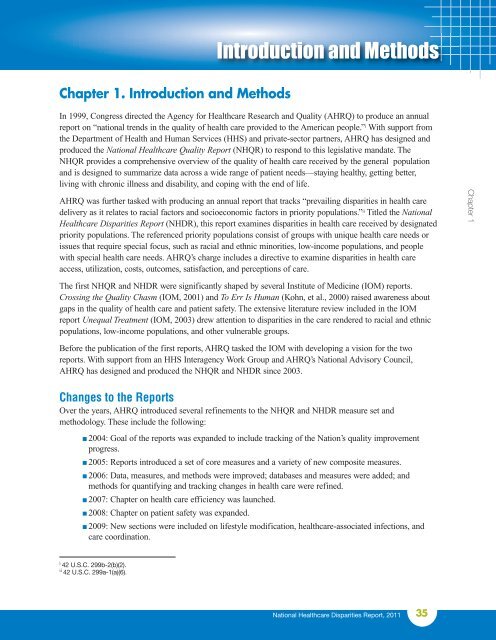National Healthcare Disparities Report - LDI Health Economist
National Healthcare Disparities Report - LDI Health Economist
National Healthcare Disparities Report - LDI Health Economist
Create successful ePaper yourself
Turn your PDF publications into a flip-book with our unique Google optimized e-Paper software.
Introduction and Methods<br />
Chapter 1. Introduction and Methods<br />
In 1999, Congress directed the Agency for <strong><strong>Health</strong>care</strong> Research and Quality (AHRQ) to produce an annual<br />
report on “national trends in the quality of health care provided to the American people.” i With support from<br />
the Department of <strong>Health</strong> and Human Services (HHS) and private-sector partners, AHRQ has designed and<br />
produced the <strong>National</strong> <strong><strong>Health</strong>care</strong> Quality <strong>Report</strong> (NHQR) to respond to this legislative mandate. The<br />
NHQR provides a comprehensive overview of the quality of health care received by the general population<br />
and is designed to summarize data across a wide range of patient needs—staying healthy, getting better,<br />
living with chronic illness and disability, and coping with the end of life.<br />
AHRQ was further tasked with producing an annual report that tracks “prevailing disparities in health care<br />
delivery as it relates to racial factors and socioeconomic factors in priority populations.” ii Titled the <strong>National</strong><br />
<strong><strong>Health</strong>care</strong> <strong>Disparities</strong> <strong>Report</strong> (NHDR), this report examines disparities in health care received by designated<br />
priority populations. The referenced priority populations consist of groups with unique health care needs or<br />
issues that require special focus, such as racial and ethnic minorities, low-income populations, and people<br />
with special health care needs. AHRQ’s charge includes a directive to examine disparities in health care<br />
access, utilization, costs, outcomes, satisfaction, and perceptions of care.<br />
Chapter 1<br />
The first NHQR and NHDR were significantly shaped by several Institute of Medicine (IOM) reports.<br />
Crossing the Quality Chasm (IOM, 2001) and To Err Is Human (Kohn, et al., 2000) raised awareness about<br />
gaps in the quality of health care and patient safety. The extensive literature review included in the IOM<br />
report Unequal Treatment (IOM, 2003) drew attention to disparities in the care rendered to racial and ethnic<br />
populations, low-income populations, and other vulnerable groups.<br />
Before the publication of the first reports, AHRQ tasked the IOM with developing a vision for the two<br />
reports. With support from an HHS Interagency Work Group and AHRQ’s <strong>National</strong> Advisory Council,<br />
AHRQ has designed and produced the NHQR and NHDR since 2003.<br />
Changes to the <strong>Report</strong>s<br />
Over the years, AHRQ introduced several refinements to the NHQR and NHDR measure set and<br />
methodology. These include the following:<br />
n 2004: Goal of the reports was expanded to include tracking of the Nation’s quality improvement<br />
progress.<br />
n 2005: <strong>Report</strong>s introduced a set of core measures and a variety of new composite measures.<br />
n 2006: Data, measures, and methods were improved; databases and measures were added; and<br />
methods for quantifying and tracking changes in health care were refined.<br />
n 2007: Chapter on health care efficiency was launched.<br />
n 2008: Chapter on patient safety was expanded.<br />
n 2009: New sections were included on lifestyle modification, healthcare-associated infections, and<br />
care coordination.<br />
i<br />
42 U.S.C. 299b-2(b)(2).<br />
ii<br />
42 U.S.C. 299a-1(a)(6).<br />
<strong>National</strong> <strong><strong>Health</strong>care</strong> <strong>Disparities</strong> <strong>Report</strong>, 2011<br />
35

















